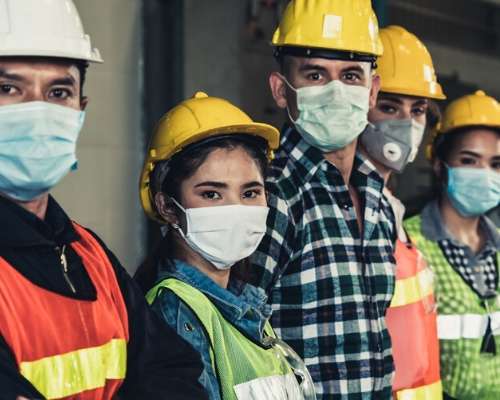6 Minute Read
April 1, 2020
0%
The beginning of the second quarter of 2020 marked the second month of quarantine for most. As the Coronavirus continues to impact the economy, things still feel far from “business as usual.” The construction industry has taken some hits and, while the short-term impact is unknown, Viewpoint continues to look towards the future. Here is a round-up of some of the top stories in April that we think you should know about:

Despite a promising start to the year, Construction Dive is reporting some hard industry news. According to an online survey by AGC (Associated General Contractors), 40% of construction firms reported having furloughed or laid off employees (as of April 10, 2020). Aside from state-mandated shutdowns, construction projects have been shut down because of issues like material shortages, infected workers and a lack of available protective equipment. Non-residential construction had traditionally been one of the last segments to enter a recession due to a near-constant backlog of projects. But with the need for workers to socially distance, backlogged projects are also being put on hold. Luckily, an additional $350B in funding has been made available for businesses through the Small Business Association’s Paycheck Protection Program. The construction industry led all other industries in getting approval for these loans with the first round of funding, and hopefully with the additional funding workers will stay on payroll and avoid having to hang up their hard hats.
The Takeaway: No one wants layoffs, but we are in an unprecedented time. Protecting the health and safety of workers is top priority and companies are having to make tough decisions. The hope is that technologies like cloud-based software and communication tools can help offset some the pain by allowing certain levels of business continuity. Having a solution like Viewpoint HR Management in place, for instance, digitizes current HR processes, allowing contractors to quickly track and meet new health and safety requirements. It also makes rehiring and onboarding of employees much easier once business is up and running again.

Speaking of those health and safety requirements, they will play a significant role in at least the short-term future of construction. The question on whether job sites should remain open is top of mind for many. While some are putting the pressure on states to close down jobsites that cannot comply with social distancing rules, others, including many trade unions, are asking for all construction work to be deemed as essential. In an effort to keep people safe, the project-heavy city of Austin, Texas commissioned a study on the safety of construction work during the COVID-19 outbreak. The study found that keeping jobsites open without precautions could triple the number of Coronavirus-related hospitalizations in the area. President of the Austin AGC Chapter, Phil Thoden said, “The study shows that if no safety and health procedures are implemented, then our industry is at risk for increasing the spread of the virus. But if the safety and health procedures required by the city and county are being followed, then there’s negligible if any spread of the virus.” Those health and safety procedures vary by city, but the study showed that risk of contracting COVID-19 could be tempered through temperature screenings, protective equipment, disinfection of tools, hand-washing stations and rotating shifts. Meanwhile, Washington Governor Jay Inslee is looking to allow some construction projects to reopen so long as specific safety rules in place.
The Takeaway: It is obvious that jobsites should comply with social distancing standards to keep their teams safe from Coronavirus. These new challenges should be faced head-on, and that includes the ability to track safety data in real-time. Technology has emerged as an area that contractors think has great potential to improve overall safety performance. The need for data gathering tools on the jobsite that can collect and analyze accurate, real-time data is growing as safety managers realize they need data to make tough decisions regarding safety.

There is no doubt that the Coronavirus has hit the construction industry hard. According to the Associated Builders and Contractors’ (ABC) Construction Confidence Index, despite a promising start to the year, confidence within the industry has fallen to below 50 for the first time ever, with just 20% of contractors reporting they expect to see increasing profit margins in the next six months. Those number are based on contractor’s expectations for sales, profit margins and staffing levels. Anirban Basu, the ABC’s chief economist noted that normally, construction is somewhat shielded from early stages of economic downturns, largely due the sheer backlog of projects. However, COVID-19 presents a different situation with projects being halted across the United States.
The Takeaway: Construction is still holding up better than many industries that took immediate losses, but it may take some time for business to fully rebound. We will likely not know the long-term impacts of the COVID for at least a few months. There are some things that contractors can do now to mitigate losses and scale operations for the future, including investing in technology, and managing cash floweffectively. The most important thing is remembering that the industry has always come back strong following previous downturns and recessions.
Regardless of recent shutdowns, the construction economy in China appears to be bouncing back quickly. The country just broke down on the largest ever soccer stadium in the world. The massive stadium, home to Guangzhou Evergrande, will seat 100,000 fans and is expected to open in December 2022. Based on this concept art, in the video below you’ll see why the project is nicknamed the “lotus stadium.” It’s a fitting moniker for a stadium in the city of Guangzhou – known as China’s Flower City.
The Takeaway: Despite less than optimistic news over the past few months, this is a good sign, as major projects around the world are starting to pick back up the pace. The blossoming lotus stadium is also a fitting symbol of hope that large gatherings will still have their place in this world moving forward.
We hope your business is faring well through this unprecedented crisis. If you haven’t already, read how Viewpoint is here to help you come out on top. To follow more news on the construction industry, please subscribe to our blog or visit viewpoint.com.
6 Minute Read
April 1, 2020
6 Minute Read
February 27, 2020
5 Minute Read
January 30, 2020